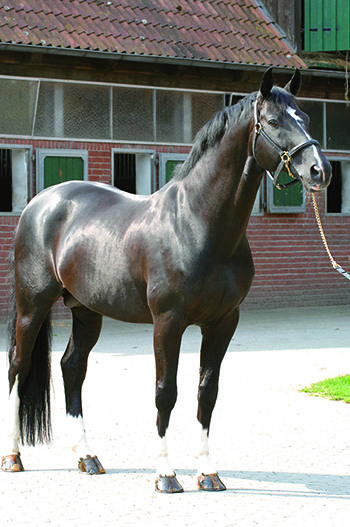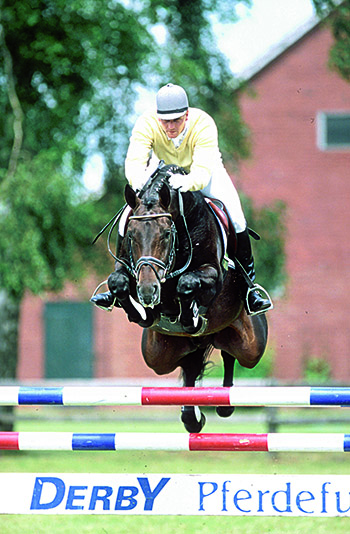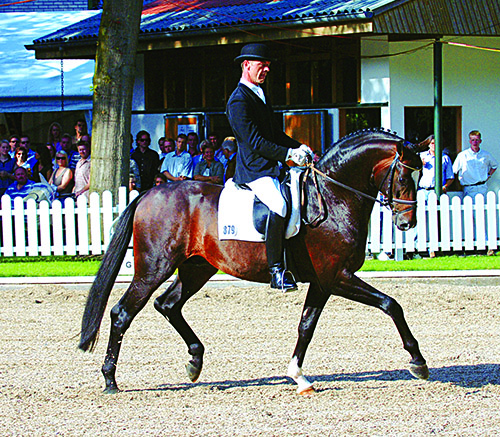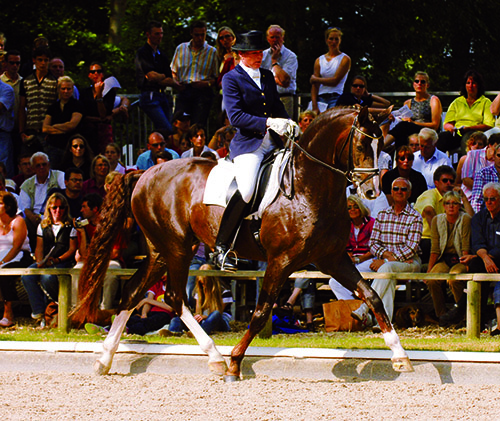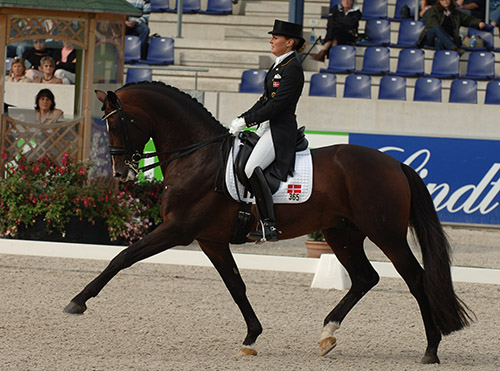By Chris Hector
Ever since 1999, the Hanoverian Verband has published a stallion year book, the Hannoveraner Jahrbuch Hengste. Each year the stallion featured on the cover is the Hanoverian Stallion of the previous year. So on the cover of the 2009 book, it is the 2008 Stallion of the Year, De Niro.
The black Donnerhall/Akzent II son was licensed in Verden in 1995 and purchased by the well-known private stallion owners, Burkhardt Wahler and Tonnes Böckmann. He stands at Wahler’s Klosterhof Medingen.
De Niro – stallion of the year (Roz Neave)
In 1994 De Niro completed his stallion performance test in Adelheidsdorf with the highest dressage score. Dolf-Dietram Keller trained him up to Grand Prix-level. In 2001, De Niro carried Keller to a win in the German Championships of professional riders and in 2003, the German Dressage Derby in Hamburg. Since 2006, he has been successfully competing with his young rider Theresa Wahler.
De Niro’s dam Alicante was successful up to medium level with Susanne Pahl, the breeder’s daughter. She was an active brood mare for only a few years. The result is impressive: Her four sons are successful competition horses, two of them, De Niro and his full brother Dimension, are approved stallions.
According to the citation from the Hanoverian Verband:
De Niro passes on his excellent rideability and fantastic movements as well as type and expression to his progeny. 1,341 offspring are registered with the Hanoverian Society. 14 of his 22 approved sons are registered with the first-class stallion book, 99 daughters were awarded state premium mare. He is the sire of 123 Verden auction foals and of 109 horses sold at riding horse auctions. 434 progeny achieved placements in the dressage ring up to advanced level and contributed to De Niro’s fantastic dressage breeding evaluation of 147 points. Together with his sons, he has an incredible impact and influence on breeding.
The Celle state stud stallion Dancier won his Stallion Licensing and stallion performance test. Desert Moon and De Janeiro were reserve champions in Verden. De Noir is one of the most popular stallions in Denmark. Maternal lines featuring De Niro in the pedigree are also very popular. His daughter De Nira is the dam of Hotline, the champion stallion of the Stallion Licensing in 2005. Hotline was the most expensive stallion ever sold at a breeding association’s sales event. Donner de Nero is the dam of the reserve champion of the Stallion Licensing in 2007, Fürst Nymphenburg, who won the stallion performance test in Adelheidsdorf in 2008.
In keeping with the inherent bias in the breeding values towards younger stallions, with a score of 123, De Niro just scrapes into the list of 37 stallions with a dressage breeding value of better than 120 on the Hanoverian dressage stallions rankings for 2009.
The Yearbook is always followed by the publication in Der Hannveraner of the annual review of Hanoverian and German FN stallion rankings by Dr Ludwig Christmann, Head of the Hanoverian Verband’s Department of International Affairs, Development and Education, who has lead the year book project from the start.
In this year’s review, Ludwig notes proudly that results show that the Hanoverian breeders have access to Germany’s best:
“Celle’s state stud sire Satisfaction is one of the top three highest valued jumper stallions in Germany. Sir Donnerhall and Breitling W convinced with strong heritable traits for the dressage arena.”
As Ludwig points out, there is not one breed value estimation, but two methods – the FN and the Hanoverian – with different databases, which can lead to different results. However, he notes: “In practice it shows, however, that the genetic tendencies almost always go in the same direction with both methods.”
“The FN on behalf of Germany’s breed associations implements the so-called integrated breed value estimation. Within the borders of Germany, all available data is taken into consideration from a wide variety of sources – therefore integrated. To be exact, four sources feed into the breed value estimation:
– Scores from the stallion performance test
– Scores from the mare performance test of the descendants
– Performance results in young horse classes, e.g. dressage and jumper horse classes, the individual scores are also taken in consideration.
– Other horse-show results, e.g. dressage and jumper classes from the A- to the S-level. The actual placement is considered for the breed value estimation.”
“The database of the breed value estimation of the Hanoverian Association is different. A comparison on a federal level does not take place; instead the comparison takes place within the Hanoverian population. Results of mare performance tests are considered as well as the impressions of the auction selection committee, which evaluates every horse that is presented for one of Verden’s auctions, in accordance with mare performance test guidelines. In addition, breed values for the exterior are recorded based on scores that were given at the mare inspection.”
FN standings…
The stallions are shown in three groups: the top 1%, the top 5% and the top 10%.
“In dressage and in jumping, the stallions with an integrated breed value of 151 or better belong to the top one percent. Stallions with a breed value in dressage of at least 135 or a breed value in jumping of at least 139 belong in the top 5 percent. The detailed chart with the breed values of individual stallions is set up according to this grouping. All stallions in Group 1 are considered top producers. A selection of a stallion from this group should not hinge upon whether a stallion scored 156 or 162 points in one or the other index. Rather it is of greater interest for the breeder to analyse the strengths and weaknesses of the individual mare, which is to be bred. In addition to the predisposition for dressage or jumping, which is marked, conformational qualities should be considered as well as the quality of the individual basic gaits.”
Ludwig pays tribute to Stakkato who with an integrated breed value of 171, is Germany’s highest ranked jumping sire: “The following numbers game proves his exceptional position: 199 of his descendants placed in jumper horse (jumper classes for younger horses) and jumper classes. 47 of them, a quarter, have already placed in classes at the S-level (most difficult), even though his oldest descendants during last year’s season were only ten years old. Because of their ages, many descendants were only allowed to compete in young horse classes or at the most up, to the M-level.”
“For the very first time, Stakkato’s sons appear in the integrated breed value estimation. They made a huge impact however: with a breed value of 162, his son Satisfaction belongs to a group of three stallions, together with Catoki by Cambridge and Caspar by Cassini, which received the second highest breed value. His oldest descendants are only four years old, and his breed value is secured by only 74%.”
This 74% is the measure of reliability – as the stallion produces more and more offspring, the measure of reliability can increase. Thus a veteran super star sire, like Contender, with generation after generation of offspring proving themselves in competition, has a reliability value of 0.99, the highest of any of the jumping sires.
However, Ludwig, points out that Satisfaction is backed by an exceptional dam-line.
“His dam Cecile delivered four successful S-level horses. After Satisfaction, Cecile produced his two internationally successful sisters Argelith Sambuca (ridden by Eva Bitter) and Sundari (under Ludger Beerbaum), as well as Emily by Escudo. Satisfaction’s own show results still have a relatively high impact. Up until now, Satisfaction has been stationed at the state-owned insemination station Ankum, which is more of a dressage station. We hope that Satisfaction will be used more across regional boundaries.”
Satisfying the Hanoverian breeders – Satisfaction
(Photo courtesy of the Hanoverian Society)
Another Stakkato son, is also making waves: “Stolzenberg is Stakkato’s second son with an excellent debut. With an integrated breed value of 150 points and a Hanoverian breed value of 152 he too is considered a top producer. He is the same age as Satisfaction. As the best jumper stallion at his approval in 2001 and as champion in the jumper index at his performance test a year later, Stolzenberg was in higher demand than his brother from the beginning. There already are available mare performance test results and auction evaluation scores of seventeen descendants. At this year’s fall auction, he had sired two top selling jumper horses, which found a new home in the barn of the internationally successful, Canadian competitor Jonathan Asselin. Compared to his sire Stakkato, he passes on to his offspring a better type, which the score for riding horse points/type in the breed value estimation reflects.”
Students of the sport of showjumping may be puzzled by the high ranking accorded to the stallion ‘Caspar’ by Cassini: However we know him better as Eurocommerce Berlin, one of the World’s most successful showjumpers with Dutchman Gerco Schroeder (NL). The stallion is now available to Hanoverian jumping breeders under his original name.
Contendro shines…
The influence of the great Holstein stallion, Contender is felt all over Germany, and in Hanover, his son Contendro has been a very important sire in recent years:
“In the Hanoverian breed value estimation he was valued with 171points, one point higher than Stakkato. This overall high evaluation is certainly justified, since he is probably next to Stakkato the sire who at present has the strongest influence on the breeding of Hanoverian jumper horses. The quotas are also exceptional. His oldest Hanoverian descendants are just six years of age. There are, however, a few descendants from his limited stallion services in Holstein as a three-year old. Three of them already successfully compete at the S-level. Out of 217 successful descendants, half, 114 to be exact, placed in jumper and jumper horse classes up to the M-level.”
And the blood of the great Voltaire, banished to Holland by the adverse opinion of the Hanoverian licensing commission, has returned:
“Celle’s Dutch state stud sire Now or Never, who distributes the valuable genes of top producer Voltaire throughout the Hanoverian region, has a similarly high breed value of 161 points. Several sons of Now or Never received very high scores in the stallion performance test, e.g. Valentino, Toronto, Uccello, and Wilton, which also are successful show competitors. For the most part, they are responsible for the high breed value of this vivacious dark bay sire.”
“Escudo I and his sons El Bundy and Embassy are also considered top producers. Escudo himself has an integrated jumper breed value of 151 points and a Hanoverian breed value of 147 points. He is definitely one of the jumper horse sires to improve the type. His son El Bundy is already valued higher than his sire with 155 points in the integrated breed value estimation and with a very close 146 points in the Hanoverian evaluation. 65 descendants of the performance test champion of 2001 have already been evaluated in mare performance tests and auction pre-selections, which secure his breed values quite well. Contrary to the expectations from his performance test results, in which he received a very high dressage index, he must strictly be considered a jumper horse producer.”
“His half-brother Embassy appears to be a more versatile producer. He also received jumper breed values around 150 points. In all four indices – riding horse points/type, foundation, dressage, and jumping – he received positive values, which the impressions of his offspring confirm. From the beginning, he attracted attention as a producer of typey and powerfully moving foals.”
“From the Hanoverian point of view, For Edition by Forsyth is one of the very promising newcomers in the integrated breed value estimation. The stallion performance test champion from 2003 received a jumper index of 150 points and a dressage index of 127 points – a high classification in both disciplines. His oldest descendants were just three years of age last year. In his son First Edition, he produced a performance test champion in his first vintage. Franziska Baum, daughter of owner Holger Baum, trains and successfully competes For Edition in jumper classes at the S-level.”
PROVEN PRODUCERS
In his examination of the dressage sires, Ludwig notes the arrival of the recent star of the Bundeschampionate, Sir Donnerhall:
“The top group of dressage sires includes many proven producers, which have been represented in this group before. Valued the highest is, however, a newcomer. Sir Donnerhall by Sandro Hit received the highest breed value estimation with 182 points, while only seven years of age, which means that his oldest descendants were only three years old, when the data was collected. His breed value is surprisingly well secured with 88 percent, in part because of his own outstanding performance test result (champion in the dressage index with 164 points), which counts in the stallion-performance-test part of the breed value.”
Sir Donnerhall – rockets to the top (Photo – Roz Neave)
“He also has a son, Sergio Rossi, who completed a 70-day performance test. The mare-performance-test part of the breed value is secured the best. In all, 26 daughters were tested, while two sons completed the thirty-day predisposition test. In the breed value part for young horse classes, his own exceptional performance counts again heavily: his victory in the Federal Championships for five-year old dressage horses and his second place at the World Championships for young horses.”
The ‘B’ line finds a champion:
Ludwig is enthusiastic about the young stallion, Belissimo M:
“From a Hanoverian point of view, he was something of a stallion of the year. With Bacchus von Worrenberg, he produced a Bundeschampion and the top seller on Verden’s fall elite auction, with his son Bergerac a bronze medal winner in Warendorf. His daughter Bella Carmina was the top seller at the broodmare auction; his son Bentley was one of the outstanding young stallions at this year’s stallion approval, where he became the highest priced horse. His son Barclay won this year’s 70-day stallion performance test in Adelheidsdorf.”
“The development, which Belissimo M underwent as a producer, is rather interesting. As a young stallion with an excellent stallion performance test and just the same results in young horse classes, he was the centre of interest. He did, however, not produce spectacular foals, even though a red thread was certainly visible in the heredity, the father’s stamp. His descendants show their true qualities now, while in training. First-class riding-horse producers need not necessarily be spectacular foal producers and vice versa sometimes too!”
Belissimo M – starring at the Bundeschampionate (Photo – Roz Neave)
Belissimo M qualified three times to go to the Bundeschampionate, and would have won the six year old dressage championship in 2005 but for a fluffed flying change, but the breeders saw the movement and the quality. The young stallion is a wonderful mixture of old and new. His sire, Beltain, a relatively neglected private stallion, was by Bolero but out of the Grande daughter, Gaenseliesel – this ‘goose girl’ was the pride of Dr Schultz-Stellenfleth’s mare band, but she was a substantial lass of more traditional than modern dimensions. On Belissimo’s dam’s side, we find the founder of the ‘R’ line, Romadour II, combined with an obscure Thoroughbred, Lucius.
In the younger group of stallions, we find Dauphin (Donnerhall / Feiner Stern) who appeared last year in the Yearbook of the FN:
“Now he also made it into the Hanoverian Yearbook Stallions. With 150 points, he is valued quite high in the breed value estimation of the FN. In the Hanoverian breed value estimation, he lies below that figure with 126 points in dressage. In all, 32 descendants have already been mare performance tested and/or evaluated at auction pre-selections. Certainly noteworthy are his very positive breed values for type, riding horse points and foundation, which can be attributed to Dauphin’s very secure dam-line.”
“For the first time Hohenstein’s son Hochadel appears in the breed value estimation. As performance test champion, he was high in demand for the first years. With a FN-breed value of 147 points, he right away made it into the top five percent nationwide; his Hanoverian breed value is, however, a little lower. He had a good introduction as producer with nine approved sons including Hohenzollern, federal champion finalist and reserve champion in dressage at his 70-day performance test in Adelheidsdorf, after his first two years of breeding services.”
The Trakehner stallion, Münchhausen continues his steady climb up the standings. He first entered the list in 2007 in 10th spot, was equal 2nd last year, and now heads the standings with an index of 151. In second place is another Trakehner, De Niro’s stable-mate at Klosterhof Medingen, Hohenstein, index 150 – but with a reliability estimation of 0.98 (compared to 0.73 for Münchhausen). The only higher reliability score goes to Weltmeyer, standing in =3rd place on an index of 149 – the reliability of his breeding value is estimated at 0.99.
It seems that high standings on the breeding index do not guarantee mares. Rohdiamant comes in =5th on 148 points, and yet only 4 foals were added to his Hanoverian progeny in the past twelve months – a similar fate has befallen that grand stallion, Davignon – over 12 months his total registered progeny rose from 990 to 992, despite a dressage index of 143 with a reliability of 0.97. (In Germany, unlike Holland and France, the numbers of mares served by each stallion, are not made publically available, however, in the case of Hanoverian stallions we can look at the number of registered offspring in the 2008 year book and compare it with the 2009 book and get a fairly accurate idea of mares covered.)
Indeed topping the standings is seemingly not enough to catch the attention of the mare owners – Münchhausen’s Hanoverian foals numbered just 2 in the last year. Hohenstein’s Hanoverian family grew by a mere 16 (683 to 689). Don Frederico was the big winner in the numbers game, with his progeny advancing from 1700 to 2091 in the twelve months. Even Hanover’s favourite son, Weltmeyer declines in popularity, adding just 42 to his total (3924 to 3967). The 1999 Yearbook, recorded Weltmeyer with 2232 progeny, the following year, the number had swelled to 2644.
Münchausen – tops the rankings but not many mares… (Photo – Roz Neave)
It’s little surprise that the 6th placegetter for 2009, Weltregent H (index 148), produced a modest 16 foals, since he is one of the few stallions in the Hanoverian breeding district available only through live cover. It’s a neat bit of niche marketing, but not likely to produce bulk books of mares.
In =7th we find yet another Trakehner resident of Klosterhof Medingen, Caprimond, tied with Belissimo on an index of 145. Ninth to that successful son of Weltmeyer, Wolkentanz on 144. Davignon completes the top ten with 143.
New faces on the 120 and above list include: Don Schufro (just one point out of the top 10), Florencio, and two sons of Donnerhall – Dressage Royal and Dauphin, and the Hohenstein son, Hochadel.
It is noticeable that jumping breeders tend to be less fashion driven than the dressage breeders, and more in tune with the breeding values. Top of the chart, Contendro’s Hanoverian progeny grew impressively in the past 12 months, from 1381 to 1538. Stakkato added 113 to his total (934 to 1047).
The third ranked horse, Adlantas As, a well performed son of Argentinus, added just 10 to his total (225 – 235) despite a jumping vale of 166.
The Holsteiner, Calido, maintained his popularity, up from 537 to 639 registrations in the past 12 months. The high ranking for Fly High (last year, he shot to 2nd place on the jumping standings, equal with Stakkato, on his first appearance on the Hanoverian standings) before dropping to 5th this year, did not impress the mare owners – just 4 foals (115 – 119) added to his total.
New faces on the Hanoverian jumping standings are: Stolzenberg (8th – 152), For Keeps 16th (equal on 145 with another For Pleasure son, For Feeling), Litas-Star (Laptop / Garibaldi II) in 17th on 144, Quidam’s Rubin (by Quidam de Revel – French blood moves slowly into Lower Saxony – out of a Landgraf mare) in = 28th on 126, and Le Cou Cou (Landadel / Goldstern), 29th on 125.
As he has ever since the Hanoverian standings were introduced in 1999, Caprimond heads the breeding values for type with an index of 181!! Don Crusador is in 2nd on 164, followed by Londonderry (162), Hohenstein (156), Stedinger (156), Lauries Crusador xx (155), Westernhagen (152), Sandro Hit (147), Embassy (145) followed by his sire, Escudo I (145). These last two might well be of interest to the eventing breeding community, combining as they do jump and type, with Embassy also offering a better than average dressage index.
In the introduction to this year’s Stallion Yearbook, Werner Schade and Ludwig Christmann, make a plea for diversity:
It is obvious that our breeders can choose among a big number of international top-class stallions. And it is also obvious that there is quite a big variety of different bloodlines, for breeding showjumping or dressage horses. But some developments give cause for concern. There are, for example, a few stallions who are popular and well-known beyond the borders of their individual breeding area, with the result that these few stallions have an imprinting influence almost all over the world. But recently, first steps of a countermovement could be observed and many stallion raisers are looking for something new. They would like to offer stallions with a pedigree not everybody yet has.
Therefore we would like to encourage you to study the Stallion Yearbook thoroughly. We are convinced that there are quite a few promising stallions who, for different reasons, are not the focus of attention, but who certainly deserve more attention. It will be worthwhile discovering them.
Counter-cyclical decisions may often be crowned by success. This also applies for horse breeding!
Once again we should be grateful to the Hanoverian Verband for making this information available, and wise breeders will heed their warning and not necessarily follow the crowd when it comes to selecting a stallion.
My thanks to Ludwig Christmann and his translator, Yvonne Zuther for making the article available to me in English.

